
Seek Out Diversity,
Appreciate Similarities,
The World Is One Family
The true philosophy of the
Tour of Gondwana
My reasons for wanting to undertake a very long tour were many. In the most basic sense, as I mentioned on the original opening page of this site, the Tour was what I was always meant to do. When I was a young student, one of my favorite pastimes was to spend hours looking at maps and trying to imagine what the various places pictorially represented on their sheets were really like. There is certainly no better way to satisfy such curiosities than to see as many new places as possible with one's own eyes. Learning about the natural history of our planet, with its millions of species of plants and animals, is also something that has always fascinated me. Observing the amazing variety of Earth's life in its natural environment is an experience without equal. The same can be said for meeting new and interesting people from all walks of life, and doing so on a daily basis. Not to be discounted are the pleasures of cycling themselves, as that, for me, is probably the perfect activity, utilitarian, fun, healthy, and absolutely non-competitive. There could be no better place to satisfy all of these desires than on the scattered pieces of the former supercontinent of Gondwana. However, there was one reason for devoting such a large fraction of my life to the Tour that proved to be more fundamental than all the others, one that made it an experience that I will never be able to equal in the future. Simply stated, the Tour allowed me to prove to myself, completely and unambiguously, an essential aspect that defines the human condition on Earth, but one that I had already known to be true.
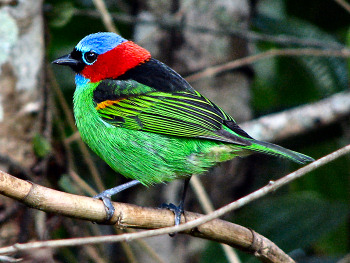
A Red-Collared Tanager in Brazil
Seek Out Diversity
What makes our World so amazing and compelling is the incredible amount of variety that has developed since life began here. That is true for the totality of our biosphere and within the human realm itself. The scale of our planet is such that, apart form the brief moment–of the past and present, but probably not much of the future–when rapid, long-distance movements have been possible, dynamic systems evolve somewhat independently, flourishing into a vast array of distinctive ecosystems and individual species. Frigid mountain glaciers, shifting desert sands, timeless meandering rivers, expansive grasslands, and verdant, primeval forests all exist as the perfect matches for the balance of chemistry, essentially meaning water, and energy, in the form of sunlight, present at different locations around the globe.
Those balances are passed on to the individual plants and animals in living in each of those places, and direct them to adapt themselves uniquely to fit the conditions of their home. There are numerous possible ways to do that, however, and life has explored most of those possibilities over time, giving us a broad palate of organisms that continuously provides opportunities for personal discovery to whomever takes the time to learn their secrets.
The distinctiveness of life can easily reveal one's location if it is otherwise unknown; when a toucan flies by, ostentatiously displaying its gigantic bill, the observer must be in the neotropics; a kangaroo hopping over a fence reveals the location to be Australia; the thunderous hoof-falls of a family of giraffe could only be heard in Africa; and the penetrating glance of a lemur only seen on Madagascar. The multiplicity of life continues to be revealed on more modest levels as well, insects, flowers, trees, and all varieties of smaller creatures, divulge their setting on the planet, and the conditions which are prevalent there, to those that observe their presence. The overarching realitiy that is obvious when one makes an effort to notice the variety of life, is that, wherever life is found, it spontaneously reaches a maximum level of diversity, and that, in all cases, that level fits the facilities of the local environment. As such, diversity can be said to be a main "goal" of evolution, and, as diversity will always be maximized within the attributes of the local environment, no one place can be said to be superior to any other.
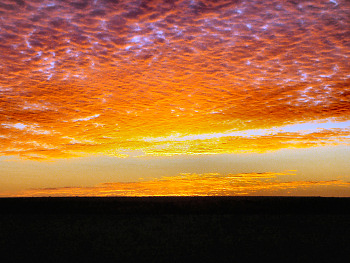
Sunset in the center of Australia
The broad scope of human societies should also be appreciated for the same reasons. When allowed to maintain regional distinctiveness, human societies naturally develop numerous different traits and practices that are unique to each. The most obvious of these, including varieties of music, cuisine, and language, are what makes traveling to other cultures worthwhile. If the entire World continues to become generalized with the lowest commonalities of popular culture and commerce, and such distinctions become increasingly diluted, our lives will be correspondingly diminished in quality.
On more subtle levels, the array of human cultures exhibit additional distinctive traits, often concerning how they perceive, and relate themselves to, the rest of the biosphere, and how they attempt to guide people towards happy lives. All of these aspects of natural and human diversity should be celebrated, as they represent numerous points of view, or unique genetic lineages, and, therefore, lead to continuous opportunities for learning. This is especially important in times such as now, when the issues facing our collective society are much too complex to be appreciated by scrutinizing them from a single point of view. There is no better way to appreciate this for oneself than to spend a considerable length of time seeking out the diversity of our World first hand, and there is no better way to do that than to travel by bicycle through the ancient heart of our living planet.
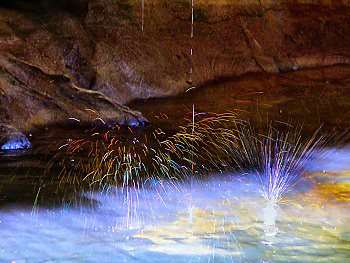
Falling water droplets refract a bright sunbeam, Isalo, Madagascar
Appreciate Similarities
In addition to recognizing the beauty of diversity, I always try to notice whatever is the same between widely separated places, the life that exists there, and the human societies that make those places their homes. There are a few good reasons for doing so. Observing such relationships in nature provides an opportunity for understanding the laws of nature themselves, which guide life towards maximum effectiveness. Such principles can often be revealed by comparing systems that exhibit convergent evolution.
In arid climates, many types of plants have thick, fleshy, water-retaining leaves and stems, and exhibit a pale silvery-green appearance. These features, which help them survive with minimal amounts of moisture, are present despite the fact that the plants may have originated in very different families. The palo verde trees of South America and the eucalypts of Australia, or, more completely, the cacti of the Americas and some of the euphorbia of Africa, are pairs that demonstrate such convergences. Originally land-based creatures that now spend most of their time in the water; sea lions, found around the World; penguins, unique to the southern shores of Gondwana; and the giant river otters of the Amazon, for example, despite originating from very different lineages, all posses streamlined body forms that help them move efficiently through a more viscous medium. These relationships reveal the importance of appreciating similarities. For when two, or more, independently developed structures arrive at the same outcome, though they may have done so though various pathways, it can be assumed that they have all arrived at the "correct" solution. With the passing of time and distance, these types of relationships can be seen all around us.
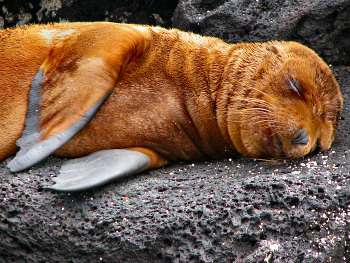
A sleeping Sea Lion pup, Islas Galapagos
Such connections are even more relevant, and just as easy to spot, in human societies. Cycling over long distances gives one the opportunity to meet many thousands of individual people. It has long been obvious to me that, in all important ways, people are the same everywhere around the globe, and the thousands of first-person encounters I had absolutely reinforced that idea. The same things are of primary importance to each of us. Young children, no mater in what circumstances they are raised, all are compelled to take part in new experiences and learn new things, and they are driven to do so by the fuel of intense emotions. As we age, after the basic requirements of food and shelter have been met, we all want the same things. The most important of these are the enriching relationships we have with our family, friends, and other people in general, and the ability to appreciate the beauty of the natural world around us. In the same way as above, because these aspects of life are clearly important to all peoples, though we have been scattered around the globe, we can be confident that the are "correctly" seen as the most important aspects of life. After so many months, in so many places, these similarities were so easy for me to spot that, in effect, I took them as a matter of course. That did not alter the importance with which I viewed their presence, however, as it is clear that they reveal the close connections we all have with each other.
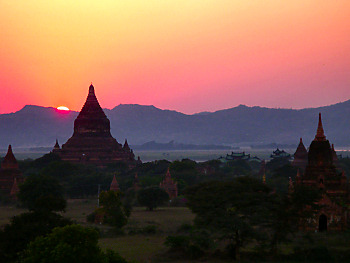
Evening at Bagan, Myanmar
The World Is One Family
Indeed, all of us are part of the same large family, whose earliest members spread around the globe in the evolutionary equivalent of the blink of an eye. Why, then, is there still so much conflict among our kind? The sidebar lists all of the violent, armed conflicts which have involved the countries of the Tour of Gondwana during my lifetime, 01964 through the end of the Tour in 02008. Looking at that list, it appears that we are constantly destroying all that we have been trying to create. I cannot accept that conclusion, however. For after observing both the diversity and similarities of our kind, which reflect that of the biosphere as a whole, I know that such a view is definitely incorrect. Violence, especially the massively organized variety, is an aberration of our true nature, of the way we all would naturally choose to spend our lives; in fellowship with each other and in concert with the flows of the World around us. That is, in fact, the question that I sought to prove to myself on the Tour, in spite of the fact that I knew the answer already. I verified that answer by constantly seeking out the diversity of our world, which shows us all that we can be, while simultaneously appreciating the similarities between us all, which reveal that, undeniably, we are one planet-wide family.
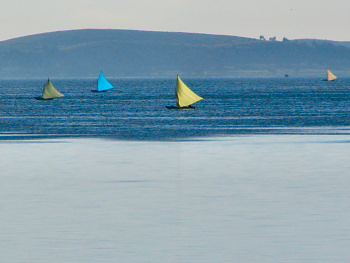
Sailboats crossing Lago Titicaca early in the morning, Bolivia
The question remains as to why there is so much violence between us. Lack of information about the vast, interconnected nature of the living systems on the Earth, must be one major factor. The only remedy for that is more, and better, education for the entirety of our family. I witnessed first had that everyone in our World wants to learn as much as much as they possibly can, but, sadly, while many cry out for knowledge, in the current era not all will have the opportunity to learn. The infuriating thing is that this is not the way it needs to be. During the years of the Tour, 02005-08, my home country, the United States expended, on military conflicts, an amount comparable to the cost of building a million rural schools worldwide, and staffing them for that same period of time. Similar outlays by other countries, and the additional monies that are spent in preparation for conflict, dramatically increase the fraction of our productive efforts that is wasted on such destructive behaviors. A roughly equivalent amount to the U.S. war expenses was diverted to the use of tobacco worldwide, a similarly destructive and pointless drain on our society. Combined together, and with all of the other useless expenses we have burdened ourselves with, that level of funds would surely be enough to bring uniform education standards to everyone in our family. While it can be done, the task is daunting indeed, primarily because there remain a relatively small number of people who will become exceedingly wealthy by manufacturing tobacco products and weapons.
Changing that situation would seem to be a priority for our family, as we enter a new World of increasingly scarce resources and climate alterations. Many, placed under such circumstances, might resort to violence to maintain the illusion of abundance in a diminishing and changing world. I believe that such a choice is even more ill advised than our long prior history of warfare. For fighting over a declining resource only weakens all the combatants further, with all continuing to be faced with the same situation of decline after the dust has settled. Those that avoid the waste and destruction of conflict may be able to devote their efforts to developing alternative societal structures and more appropriate applications of our capabilities. If that is to occur, we would be wise to request the input of those who share similar desires for a life of enlightenment, but who speak with the diversity of many different points of view. I have heard their voices.
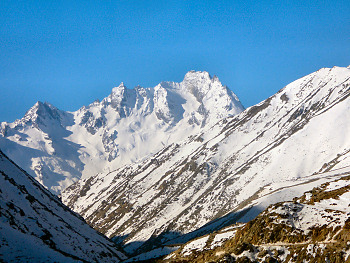
Snowy peaks in the Himalaya of Tibet
Yes, I know now that my family is much larger than I ever realized. I have heard their voices. Sometimes, I wonder about those family members I had the good fortune to meet for the first time during the Tour. I wonder if my friend the Coca-Cola man from Kainatu, Papua New Guinea, has managed to stay clear of the local Raskols. I wonder if my Tibetan guide, who walked alone over a snowy mountain to help me push my bike past an avalanche, lost his livelihood when the Chinese military suppressed his country again. I wonder if the nice lady and her mother, who ran the guest house in Kalkudah, Sri Lanka, and who lost all the male members of their family in the Tsunami of '04, were displaced when war returned to their part of the World not long after I left. I wonder about all the seamen, with whom I shared many happy days at sea, and whether they have had to flee from others from their trade, whose best choice in life has been to become pirates. I wonder about the men who still work the mine at Potosi, high in the Andes, and if they have been able to avoid contracting silicosis. I have heard their voices.
I also wonder about the many babes and small children who shouted greetings as I arrived in their villages. Their voices could never be ignored. By the time I finished the Tour some of them must have, perhaps, doubled in size, and I wonder if they still have a memory of the odd-looking man who passed by and waved to them one day. Most of all, I wonder about the many, many people I met who live contented lives far away from the general insanity that is the modern world, and who never want to give up their connections to the beautiful World around them. Above all, I have heard their voices. For they and I share another idea, which I have long suspected, and which I also proved to myself with forty months of cycling. Simply said, it is that the key to a life of happiness is to appreciate the Universe the way that it is. That may sound fanciful, but it is a philosophy that ultimately reveals itself through various approaches, from the contemplative to the scientific.
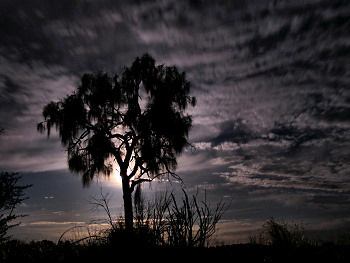
Moonrise and a Casuarina tree, central Australia
It is the Universe the way that it is, and the natural laws which govern it, that have created all of the most beautiful and amazing things that we see around us. All of the images on this page reflect the Universe the way that it is, and there are many other things, even more beautiful, still awaiting us out there, within its complex form. It is only when we seek to change the Universe to be more attuned to our liking that we cause problems for ourselves. We don't like that perpetual expansion is not possible in a finite World, so we try to circumvent that issue. We become accustomed to inactivity, so we seek out devices that will assuage the inconvenience of labor. We ignore the unintended consequences of our actions, leaving them for our descendents to deal with later. This type of reasoning leads only to disaster, but can largely be ameliorated by appreciating the Universe the way that it is.
For it is the Universe as it is now, and as it has always been, that has brought forth the exquisite diversity of life and structure that we see all around us every day. It is the collection of fundamental laws of the Universe that have produced such similarities in all of us that we all show the same ability to learn and understand. These are not things to be overcome; they are things to be embraced. For accepting the Universe as it is brings the truest form of freedom. It is the freedom to live apart from unachievable goals. I decided to bicycle around the Earth, and I knew that such an idea was well within my abilities, as the level of effort required would only have been ordinary when our species was young and newly emergent on the Earth. As I progressed, I endeavored to accept the Universe as it is, especially in the areas that most affect such an attempt; the need for energy; the force of wind; the effects of gravity, among others. In so doing, I traveled with the freedom of knowing that my journey's success was assured, and, therefore, that I could completely enjoy every minute of it. We truly live in a wonderful world, one filled with amazing people. That is what I would like others to know about our home as it is today.
I set out to learn that lesson once and for all, to appreciate the Universe in all its glory; and that task became a simple one once I chose to Tour the ancient lands that were once joined, the lands once known as Gondwana.
I would like to thank all of those
who have viewed and read this site.
Previous | Next
Main Index | Pre-Tour Index
Post-Tour Index | Articles Index
Slideshows
Main Index
Pre-Tour
Post-Tour
Articles
Previous
|
Gondwana
In Conflict
Australia
Limited participation in:
Indonesia-Malaysia Conflict
01962-66
Southeast Asia War
01962-75
Persian Gulf War
01991
Third Afganistan War
02001-present
Iraq War
02003-present
Papua New Guinea
Bougainville Island Rebellion
01990-02003
Timor Leste
Indonesian Invasion
01975-02002
Malaysia
Indonesia-Malaysia Conflict
01962-66
Malayan Civial War
01967-89
Cambodia
Southeast Asia War
01970-75
Cambodia-Khmer Rouge Civil War
01975-98
Laos
Southeast Asia/Civil War
01964-75
Myanmar
Civil/Ethnic Wars
continuous
Bangladesh
Independence War
01971
Tibet
Chinese Invasion
01959 to present
Nepal
Civil War
01996-02006
Sri Lanka
Civil War
01983-02009
India
Second India-Pakistan War
01965
Third India-Pakistan War
01971
Ethiopia
Eritrean Independence War
01961-93
Eritrean War
01998-02000
Civil War
01974-91
Ogaden War
01977-78
Somalia IC War
02006-08
Tanzania
Uganda-Tanzania War
01978-79
Rwanda
Civil/Ethnic Wars
01967,90-91,94
Burundi
Civil/Ethnic War
01993-02003
South Africa
Namibia Independence Conflict
01966-88
Argentina
South Atlantic War
01982
Peru
Civil War
01980-02000
Ecuador Border War
01981, & -85
Ecuador
Peru Border War
01981, & '85
Colombia
Civil War
01968-present
Panama
US Invasion
01989
Nicaragua
Sandinista/Contra Wars
01978-90
Honduras
The Soccer War
01969
The Contra War
01986-87
Guatemala
Civil War
01961-96
Mexico
Chiapas Rebellion
01994
United States
Southeast Asia War
01965-75
Grenada Invasion
01983
Libya Attack
01986
Panama Invasion
01989
Persian Gulf War
01991
Third Afganistan War
02001-present
Iraq War
02003-present